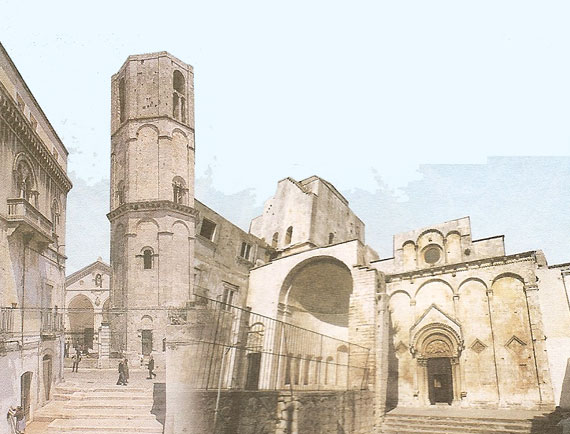Welcome to Gargano - Gargano for vacation
- The towns and
villages of the Gargano Peninsula
Europe
> Italy >
APULIA ->
GARGANO
- Italy >
APULIA ->
SALENTO
Discover the most profound
soul of the Gargano promontory through the most weil
known places of worship since ancient times. Crossing
the
Umbra Forest,
the heart of the Gargano National Park,
we visit the oldest
Christian sanctuary, that of the
Basėlica-Grotto of the appearance of the
Archange! Saint Michael at Monte Sant'Angelo. In
the afternoon, we go to the most well known Sanctuary
of modern times: in San Giovanni Rotondo, where Saint
Padre Pio, the Monk with Stigmata, lived and performed
his miracles.
Maps
territory of Gargano.

They call it "(he spur of Italy" for
the way it projects from the heel of Italy's boot,
conjuring visions of a remote past when it was an
island. Much later, the tnillen nia brought movements
of land and sea, and its joining the rest of the
peninsula. This is the Gargano, an ancient land rich
in traditions and history, charm and discovery,
landscapes and panoramas, colours and atmospheres,
vegetation and animals, and flavours and rarities.
Through the age-old flavours and fragrances of the
food-and-wine traditions, you can ready get to know
Gargano, this ancient land with its peasant
traditions. Here traditional methods are still used
for the picking and production of olives, grapes and
all the other products that constitute the jewel in
the crown of apulian cuisine.  food-and-wine traditions
food-and-wine traditions
A biological microcosm, a rare collection of animal
and vegetable species that wonderfully represent the
wealth of nature that Italy can boast. Animals thrive
here that are no longer found elsewhere in Italy.
Plants and flowers grow here that are an evocative
sample of Italy's most entrancing landscapes.
This heritage could not be left to the unwitting - and
invariably dangerous -hands of Man; a heritage which
is naturalistic and environmental but also cultural
and folkloristic, and which needed safeguarding,
preserving and improving. The Gargano National Park was born with precisely these goals. After various
institutional battles and set up in 1995 with the law
on Italy's protected areas (Law no. 394/91), the Park
today covers a surface area of about 120,000 hectares,
taking in 18 Municipalities of the Province of Foggia
( Pugnochiuso, Mattinata, Peschici, San Menaio, Rodi Garganico, San Giovanni Rotondo, Apricena, Cagnano Varano, Carpino, Ischitella, Island Tremiti, Lesina, Manfredonia, Monte Sant Angelo, Poggio Imperiale, Rignano Garganico, San Marco in Lamis, Sannicandro Garganico, Serracapriola, Vico del Gargano, ) and a population of more than 200,000 inhabitants. Its
head office is in Monte Sant'Angelo.
The Park's establishment was made operative through a
system that safeguards and manages its area by
pursuing certain precise goals: the preservation of
animal and plant species, and geological and
ecological sites; the improvement of the environmental
heritage and its utilisation, while looking forward
towards its sustainable development; the enhancing of
awareness of the policies that seek to respect and
safeguard the Park's systems; and lastly, the defence
and rebuilding of the Park's eco-environmental
balances. This is the Park's way forward. This is the
Gargano National Park. Of the many species of
fauna to be found in this area, the pride of the
Gargano National Park is the Gargano roe.
Almost impossible to find in other areas of Italy,
there are approximately one hundred specimens here.
Also to be found are wild cats, colonies of
woodpeckers, peregrines, buzzards, kestrels and
lanners.An incredible variety of aquatic and pelagic
species live in the coasta! and lake areas, from
Lesina and Varano to the Tremiti islands,
from the humid areas of Frattarolo to the
Salso Lake. Wild ducks, seagulls, and coots,
living amongst the reeds, bamboo canes, tamarisks,
pools and stretches of water, are some of the more
easily identifiable species. Besides them, the red
heron, reedling and tobacco duck build their nests
here, and it is easy to see ospreys, wild geese,
shearwaters and peregrines.

The towns and
villages of the Gargano Peninsula have
evolved at the meeting points of the natural
conditions and the population's living requirements.
They are in this sense an integral par! of the
Gargano National Park and are thus part and parcel
ol the great landscape heritage. Their names are:
Apricena, Carpino, Ischitella,
Lesina, Manfredonia, Mattinata,
Monte Sant'Angelo, San Giovanni Rotondo,
Serra Capriola, Peschici, Vico del
Cargano, Sannicandm Garganėco, Cagnano
Varano, San Marco in Lamis,
VIESTE,
Rodi Garganico, Rignano Garganico and
the
Tremiti Islands.
The distribution of
the human settlements in the Gargano Peninsula
seems to obey a pattern of respect - reticence even -
towards its heart, with its dark and ancient forests.
By developing around its edges, the villages have left
alone the higher parts of the broad plateau. This,
together with the area 's history and culture of
farming, forestry and animal husbandry, has
contributed to preserving its identity.
As well as
their geographical distribution, the Gargano's
villages are fascinating for their history and
architecture. The latter is noteworthy for the
construction types and materials used: over the
centuries, the use of local materials has made today's
villages blend seamlessly with their surroundings,
adding to their allure and value. These
characteristics make the villages an integral part of
the Gargano National Park, a heritage of
historical, artistic and cultural importance that must
be preserved and consolidated. The single-unit housing,
characteristic terraces, outside staircases, arches,
and fish-bone patterns all give the urban landscape a
unique touch and thus contribute to the magical and
evocative auras of the old towns. The district of
Iunno in Monte Sant'Angelo or the
historical centres of Vieste, Vico del
Gargano and Peschici are just two such
examples.
|



